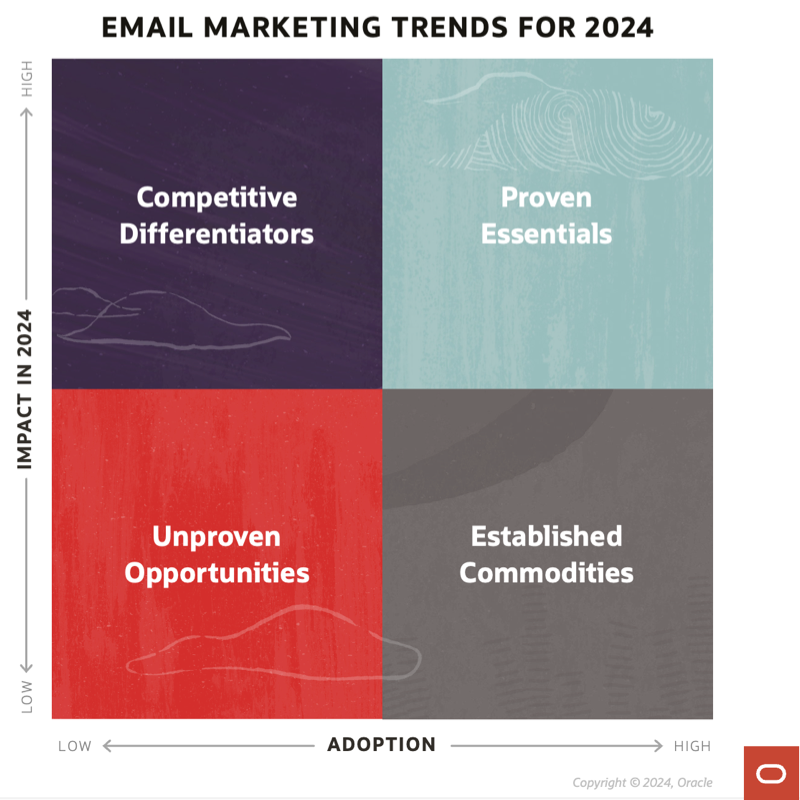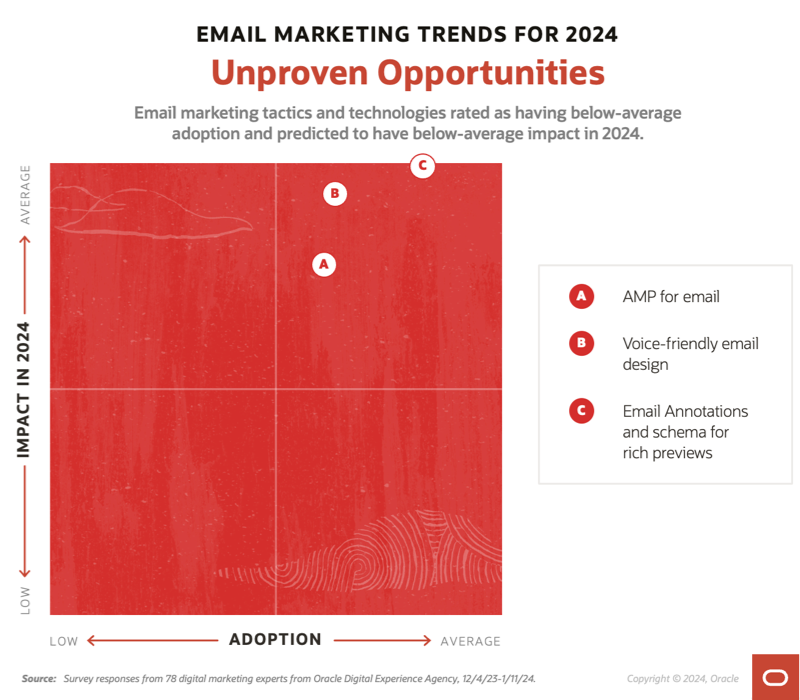Email marketing is constantly evolving, so it can be difficult to know where to invest your time and energy from year to year. Just a few of the recent changes and challenges that email marketers have had to deal with include:
- Economic uncertainty caused by high interest rates
- New deliverability requirements from Google and Yahoo
- The 2-year anniversary Apple’s Mail Privacy Protection making inactivity management much more difficult
- Generative AI raising concerns and opportunities across the marketing spectrum
To help you prioritize your email marketing efforts this year, we surveyed some of Oracle Digital Experience Agency’s hundreds of digital marketing experts, asking them to rate the current adoption of a range of email marketing technologies and tactics, as well as the impact they predict each of them will have in 2024. We then mapped the results into adoption-impact quadrants.
In this post, we’re looking at the Unproven Opportunities, which are in the low adoption–low impact quadrant. The technologies and tactics here are not fully vetted and may not generate long-term adoption or impact. There are significant risks that could undermine your investment in part or entirely—including rejection by consumers, inadequate inbox provider support, inadequate digital marketing platform support, the passage of legislative impediments, and other issues.

Because of those risks, most brands will find that the best strategy is to wait and let others work out all the details, uncover the best practices, and stress-test the technologies. However, the pioneering companies who embrace these trends at this early stage may seize a sizable advantage over their competitors.
Of the 26 trends we surveyed our digital marketing experts about, three of them were rated as being in the low adoption–low impact quadrant for 2024. Let’s talk about each of them in turn.

A. AMP for Email
Launched in 2019, AMP for email is a set of open standards created by Google for creating what they call “dynamic emails,” which allow marketers to bring functionality that’s common on the web into their email designs. For example, AMP for email allows live forms, carousels, accordions, and hamburger menus to be used in emails. AMP for email also allows for live content that is populated at the time that the email is opened rather than the time the email is sent.
While it had early buzz, momentum has stalled in the US due to a range of headwinds, including:
- The pandemic, which led to marketing layoffs and massive changes in customer behaviors, and caused marketers to focus on the basics, not “extras” like AMP for email
- Microsoft halting its AMP for email pilot, which surprised many and stopped the standard from gaining support in another major mailbox.
- Google stepping back from AMP for email and shutting down its AMP Fest conference, wanting the standard to stand on its own and not become synonymous with their company
- Google also dramatically deemphasizing AMP for webpages, which caused confusion about AMP for email as people proclaimed, “AMP is dead!”
- Apple launching Mail Privacy Protection, which focused marketers on preserving their email audiences, not on adding new capabilities like AMP for email
Despite the potential to make email campaigns more compelling, the disinterest by brands has caused two interrelated adoption challenges for AMP for email. The first is a lack of support from email service providers (including Oracle), and the second is a lack of interest from brands.
“While it’s supported by Gmail and Yahoo, it’s not enough for most brands,” says Daniel Deneweth, Head of Email Deliverability Services at Oracle Digital Experience Agency. “To break out and become a viable trend, Apple would need to support it. And given Apple’s focus on privacy, it’s highly unlikely they’d want to expand email functionality. No, marketers will need to find other ways to enhance their email functionality, including CSS-based interactivity and live content.”
Explore the pros and cons of AMP for email.
B. Voice-Friendly Email Design
While email accessibility and inclusive design have been major trends over the past several years—with each of those having their place—brands haven’t been motivated to make their email designs voice-friendly for screen readers and voice assistants.
This stalled, fledgling trend is held back by three powerful facts:
- We have no idea how many emails are being read via screen readers and voice assistants since dictating an email doesn’t trigger its tracking pixel.
- Nearly all email marketing calls-to-action currently drive the subscriber to a webpage or mobile app, which is problematic for voice assistants, short-circuiting the path to conversion.
- Most marketing emails are optimized for visual communication, not verbal communication.
“With voice assistants, there are no standards for developing emails with this technology besides accessibilities best practices,” says Henry Alva, Email and Web Developer for Creative Services at Oracle Digital Experience Agency. “And even accessibility varies widely across email clients and operating systems.”
Our advice is to focus on broader accessibility and inclusive design initiatives, and pay extra attention to voice-optimizing your envelope content.
Dive deeper into how voice assistants read emails and how marketers can adapt.
C. Email Annotations and Schema
There’s a lot to be excited about with Gmail’s Email Annotations and Yahoo Mail’s schema, says Puneet Singhal, B2B Consulting Associate at Oracle Digital Experience Agency. “They allow companies to highlight crucial information for recipients, including expiration dates, deadlines, and promo codes. This makes engaging with emails easier.”
However, many of the same issues that plague AMP for email, including limited support and extra coding effort, also plague annotations and schema. An additional problem is that the discounts codes, quick action links, and other functionality these enable often break email attribution, says Heather Goff, Strategic Director of Email Deliverability Services at Oracle Digital Experience Agency.
“In many cases, clicks on the schema-powered email content placed at the top of the inbox above the email itself, end up coming through as direct website traffic rather than email-attributed,” she says. “For many brands, especially those using last-click attribution models, that can mean credit isn’t properly given to the email channel, which can adversely affect channel budgeting and success metrics. Marketers are being asked to do more with less resources right now, so it’s understandable they’re less than excited to spend operational effort on something that shifts performance from email to their web and media teams.”
Learn more about the opportunities and concerns with Gmail’s Email Annotations.
Trends on the Move
Long-time readers of our survey will know that universal control groups have been bouncing back and forth between being an Unproven Opportunity and a Proven Essential. After being in the former bucket last year, it’s now in the latter, as attribution concerns heat back up.
AMP for email, voice-friendly email design, and schema have all been stuck in our Unproven Opportunity quadrant all five years of our survey.
For a full look at all 26 email marketing trends to watch for in 2024, also check out our posts that examine:
- Competitive Differentiators, which are high-impact trends with low adoption
- Proven Essentials, which are high-impact trends with high adoption
- The Biggest Shifts in Email Marketing Trends for 2024
Also, for a better understanding of how all of these email marketing trends are evolving, check out our email marketing trends posts from last year:
- Email Marketing Trends for 2023: Unproven Opportunities
- Email Marketing Trends for 2023: Competitive Differentiators
- Email Marketing Trends for 2023: Proven Essentials
- The Biggest Shifts in Email Marketing Trends for 2023
—————
Need help with your email marketing campaigns? Oracle Digital Experience Agency has hundreds of marketing and communication experts ready to help Responsys, Eloqua, Unity, and other Oracle customers create stronger connections with their customers and employees—even if they’re not using an Oracle platform as the foundation of that experience. Our award-winning specialists can handle everything from creative and strategy to content planning and project management. For example, our full-service email marketing clients generate 24% higher open rates, 30% higher click rates, and 9% lower unsubscribe rates than Oracle Responsys customers who aren’t.
For help overcoming your challenges or seizing your opportunities, talk to your Oracle account manager, visit us online, or email us at OracleAgency_US@Oracle.com.
